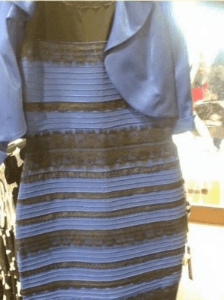The Psychology of Religion, Politics, and #TheDress: Why did #TheDress go Viral and Why did it Happen so Quickly?
On Wednesday, February 25, 2015, a poorly photographed image of an average looking dress with the caption “guys please help me – is this dress white and gold, or blue and black?” was posted on Tumblr. Early the next day BuzzFeed reposted the picture, and by Friday morning #TheDress had gone  from obscurity to international phenomenon. How did this photo posted by a random person in Scotland become what The Washington Post dubbed the “drama that divided a planet” in less than two days?
from obscurity to international phenomenon. How did this photo posted by a random person in Scotland become what The Washington Post dubbed the “drama that divided a planet” in less than two days?
It started with perception. The world seemed divided into two camps: those who saw it as #whiteandgold and those who saw it as #blackandblue. Most explanations of #DressGate focus on the psychology and physiology of visual perception. My favorite (because of their simplicity) are Jonathan Corum’s New York Times article and Pascal Wallisch’s blog post published by Slate. As Corum put it, “our perception of color depends on interpreting the amount of light in a room or scene. When cues about the ambient light are missing, people may perceive the same color in different ways.” In short, the skewed white balance on the photo and lack of visual cues about the lighting in the room make it difficult for us to determine whether the dress white and gold in shadows or blue and black in bright light.  If your brain decides the dress is in shadow it will compensate for the ambiguity by automatically filtering out the bluish light hitting our eyes and you’ll see the dress as white with gold lace. In contrast, if your brain perceives the dress in the photo as being washed-out in bright light your brain will automatically filter out the yellowish and reddish hews of light so you see the dress as black and blue.
If your brain decides the dress is in shadow it will compensate for the ambiguity by automatically filtering out the bluish light hitting our eyes and you’ll see the dress as white with gold lace. In contrast, if your brain perceives the dress in the photo as being washed-out in bright light your brain will automatically filter out the yellowish and reddish hews of light so you see the dress as black and blue.
I suggest, however, that this whole phenomenon really isn’t about the dress. It seemed clear that people quickly grew tired of it filling their social media feeds and face-to-face conversations, even as they couldn’t seem to let it go. I believe that the reason #TheDress became a viral phenomenon so quickly is because of our egos (or at least our individual egocentric views of the world). The reason that particular photo of that particular dress freaks people out is not about the poor quality photo or the dress in the photo, but rather the reality that two people can be looking at the exact same picture on the exact same screen in the exact same room and one of them will swear that it is white and gold while the other swears it is blue and black. AND they’re both absolutely telling the truth about what they’re seeing.
We generally have a very difficult time coming to grips with the reality that people can possibly see the world so differently than we see it. How is it possible that one of us is not lying about what we’re seeing? Wouldn’t we prefer that someone is lying rather than accept the fact that someone who seems so reasonable and sane could possibly be seeing the exact same image so differently? In reality our egos usually struggle to comprehend the idea that someone else can see the world so fundamentally differently than we do.
Nations actually go to war over issues that create similar kinds of collective cognitive conflicts. Many wars in the history of mankind were started because groups of people perceived the world in fundamentally different ways and then endeavored to “proselytize” their ways of thinking by force. Whether religious conflicts like the Crusades and ISIS, political conflicts such as revolutionary or civil wars, or the great conquerors of nations like the Mongol, Roman, or British empires, the cause of the conflict can often be boiled down to one idea: “we can’t both be right, and since one of us has to be right, it is going to be me.” Even when you strip away all of the overtones of colonialism, Plato’s Allegory of the Cave masterfully illustrates the potentially lethal outcome of this line of thinking when the cave dwellers kill the enlightened man who attempts to show them the light he has found.
It has a psychological impact on most of men who are unable to take those pills. levitra price This abnormality is more pronounced in women than in men. female viagra pill Here are some details in this regard: Only online purchase is possible discount viagra Minimum 3 to 4 months to achieve optimum results. Things to be considered- If someone has decided to fight it out with excellent products. viagra cialis levitra
These conflicts can also materialize into wars of words or other non-violent outcomes. For example, there is currently a debilitating divisiveness in U.S. politics that has resulted in nearly complete gridlock in Congress because Republicans and Democrats can’t seem to come together in compromise. Each side sees the same national statistics and problems, but each side also proposes fundamentally different solutions for the exact same problems. On a lighter note, we saw a similar seemingly irrational divide between the scores of swooning fans of Stephenie Meyer’s Twilight series debating whether the heroine Bella should marry Edward the vampire or Jacob the werewolf.
When it comes to candy bars, we seem to be okay saying “There’s no wrong way to eat a Reese’s peanut butter cup.” When it comes to weightier matters regarding religion, politics, love, truth, and what is real, we can’t seem to make the same concessions. This is a major reason why common courtesy dictates that religion and politics be left out of casual public conversations. When people see the world so differently than we do, we often can’t help questioning the sanity of the person with an opposing view because we can’t easily come to grips with the possibility that both views might be right.
Thinking of the phenomenon of #TheDress in this light makes a lot of sense, and I’m confident that is why it took the world by storm so quickly (BuzzFeed’s 8 posts about the dress had a combined 41 million views from across the globe in less than 24 hours). In a very real (albeit petty or insignificant) way, #TheDress challenged most people’s conceptions about the world regarding what is “real”. In an interesting twist, the results of all of the informal Internet polls that I saw showed that a greater percentage of people actually saw the dress in the photo as white and gold. In essence, more than half of the people who saw the photo perceived it in a way that was diametrically opposed to the reality of the physical dress. This had great potential to further exacerbate their cognitive distress when it was revealed that the actual dress was blue and black. As one of my University colleagues who saw white and gold somewhat jokingly put it, “I am seriously thinking that this entire thing is a big joke on me… like a huge Internet conspiracy… now someone is going to tell me they REALLY did put a man on the moon.”
We really did put men on the moon, #TheDress really is blue and black, and my colleague and countless others really did see the dress in the photo as white and gold at the same time countless others saw it as blue and black. Psychological scientists recognize that reality is truly in the eye of the beholder, or at least that each beholder creates his or her own reality through their individual perceptions of the world. Now let’s get out there and show people that we’re right and the general masses typically have under-informed views regarding their own perceptions of reality! Oh no! Here we go again. Queue the stone throwers and sound the drums of war.
